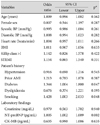1. Granger CB, Goldberg RJ, Dabbous O, et al. Predictors of hospital mortality in the global registry of acute coronary events. Arch Intern Med. 2003. 163:2345–2353.
2. Antman EM, Cohen M, Bernink PJ, et al. The TIMI risk score for unstable angina/non-ST elevation MI: a method for prognostication and therapeutic decision making. JAMA. 2000. 284:835–842.
3. Richards AM, Nicholls MG, Yandle TG, et al. Plasma N-terminal pro-brain natriuretic peptide and adrenomedullin: new neurohormonal predictors of left ventricular function and prognosis after myocardial infarction. Circulation. 1998. 97:1921–1929.
4. James SK, Lindahl B, Siegbahn A, et al. N-terminal pro-brain natriuretic peptide and other risk markers for the separate prediction of mortality and subsequent myocardial infarction in patients with unstable coronary artery disease: a Global Utilization of Strategies To Open occluded arteries (GUSTO)-IV substudy. Circulation. 2003. 108:275–281.
5. Iwanaga Y, Nishi I, Furuichi S, et al. B-type natriuretic peptide strongly reflects diastolic wall stress in patients with chronic heart failure: comparison between systolic and diastolic heart failure. J Am Coll Cardiol. 2006. 47:742–748.
6. Goetze JP, Christoffersen C, Perko M, et al. Increased cardiac BNP expression associated with myocardial ischemia. FASEB J. 2003. 17:1105–1107.
7. de Lemos JA, Morrow DA, Bentley JH, et al. The prognostic value of B-type natriuretic peptide in patients with acute coronary syndromes. N Engl J Med. 2001. 345:1014–1021.
8. Raymond I, Groenning BA, Hildebrandt PR, et al. The influence of age, sex and other variables on the plasma level of N-terminal pro brain natriuretic peptide in a large sample of the general population. Heart. 2003. 89:745–751.
9. Anwaruddin S, Lloyd-Jones DM, Baggish A, et al. Renal function, congestive heart failure, and amino-terminal pro-brain natriuretic peptide measurement: results from the ProBNP Investigation of Dyspnea in the Emergency Department (PRIDE) Study. J Am Coll Cardiol. 2006. 47:91–97.
10. Das SR, Drazner MH, Dries DL, et al. Impact of body mass and body composition on circulating levels of natriuretic peptides: results from the Dallas Heart Study. Circulation. 2005. 112:2163–2168.
11. Mehra MR, Uber PA, Park MH, et al. Obesity and suppressed B-type natriuretic peptide levels in heart failure. J Am Coll Cardiol. 2004. 43:1590–1595.
12. Lee KH, Jeong MH, Ahn YK, et al. Gender differences of success rate of percutaneous coronary intervention and short term cardiac events in Korea Acute Myocardial Infarction Registry. Int J Cardiol. 2008. 130:227–234.
13. Low S, Chin MC, Ma S, Heng D, Durenberg-Yap M. Rationale for redefining obesity in Asians. Ann Acad Med Singapore. 2009. 38:66–69.
14. Kim SH, Kim JS, Baek KK, et al. Role of NT-proBNP in evaluation of functional status in congestive heart failure. Korean Circ J. 2004. 34:894–899.
15. Baek KK, Jeon ES, Rhee I, et al. N-terminal pro-B-type natriuretic peptide as a prognostic marker in acute coronary syndrome. Korean Circ J. 2004. 34:1070–1081.
16. Kim KS, Han HS, Hwang KK, Youn TJ, Kim DW, Cho MC. The plasma level of N-terminal pro B-type natriuretic peptide (NT-proBNP) for severity of coronary artery stenosis and early risk stratification in patients with non-ST elevation acute coronary syndrome. Korean Circ J. 2004. 34:133–141.
17. Jernberg T, Stridsberg M, Venge P, Lindahl B. N-terminal pro brain natriuretic peptide on admission for early risk stratification of patients with chest pain and no ST-segment elevation. J Am Coll Cardiol. 2002. 40:437–445.
18. de Lemos JA, McGuire DK, Drazner MH. B-type natriuretic peptide in cardiovascular disease. Lancet. 2003. 362:316–322.
19. Killip T 3rd, Kimball JT. Treatment of myocardial infarction in a coronary care unit: a two year experience with 250 patients. Am J Cardiol. 1967. 20:457–464.
20. Wang TJ, Larson MG, Levy D, et al. Impact of obesity on natriuretic peptide levels. Circulation. 2004. 109:594–600.
21. McCord J, Mundy BJ, Hudson MP, et al. Relationship between obesity and B-type natriuretic peptide levels. Arch Intern Med. 2004. 164:2247–2252.
22. Tosa S, Watanabe H, Iino K. Usefulness of plasma BNP levels as a marker of left ventricular wall stress in obese individuals. Int Heart J. 2009. 50:173–182.
23. Licata G, Volpe M, Scaglione R, Rubattu S. Salt-regulating hormones in young normotensive obese subjects: effects of saline load. Hypertension. 1994. 23:1 Suppl. I20–I24.
24. Morabito D, Vallotton MB, Lang U. Obesity is associated with impaired ventricular protein kinase C-MAP kinase signaling and altered ANP mRNA expression in the heart of adult Zucker rats. J Investig Med. 2001. 49:310–318.
25. Choe HM, Yoo BS, Ryu HY, et al. The early changing pattern of the B-type natriuretic peptide concentration and its significance as a prognostic marker after acute myocardial infarction. Korean Circ J. 2006. 36:526–534.











 PDF
PDF ePub
ePub Citation
Citation Print
Print




 XML Download
XML Download